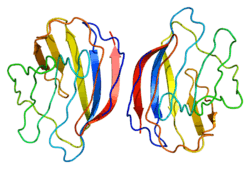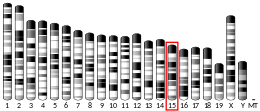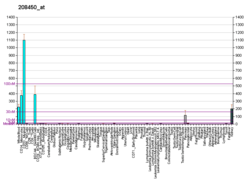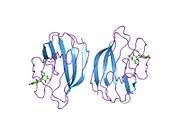Galectin-2
Galectin-2 is a protein that in humans is encoded by the LGALS2 gene.[5][6][7]
| LGALS2 | |||||||||||||||||||||||||
|---|---|---|---|---|---|---|---|---|---|---|---|---|---|---|---|---|---|---|---|---|---|---|---|---|---|
 | |||||||||||||||||||||||||
| |||||||||||||||||||||||||
| Identifiers | |||||||||||||||||||||||||
| Aliases | LGALS2, HL14, galectin 2 | ||||||||||||||||||||||||
| External IDs | OMIM: 150571 MGI: 895068 HomoloGene: 4741 GeneCards: LGALS2 | ||||||||||||||||||||||||
| |||||||||||||||||||||||||
| |||||||||||||||||||||||||
| |||||||||||||||||||||||||
| Orthologs | |||||||||||||||||||||||||
| Species | Human | Mouse | |||||||||||||||||||||||
| Entrez | |||||||||||||||||||||||||
| Ensembl | |||||||||||||||||||||||||
| UniProt | |||||||||||||||||||||||||
| RefSeq (mRNA) | |||||||||||||||||||||||||
| RefSeq (protein) | |||||||||||||||||||||||||
| Location (UCSC) | Chr 22: 37.57 – 37.58 Mb | Chr 15: 78.85 – 78.86 Mb | |||||||||||||||||||||||
| PubMed search | [3] | [4] | |||||||||||||||||||||||
| Wikidata | |||||||||||||||||||||||||
| |||||||||||||||||||||||||
The protein encoded by this gene is a soluble beta-galactoside binding lectin. The encoded protein is found as a homodimer and can bind to Lymphotoxin alpha. A single nucleotide polymorphism in an intron of this gene can alter the transcriptional level of the protein, with a resultant increased risk of myocardial infarction.[7]
References
- GRCh38: Ensembl release 89: ENSG00000100079 - Ensembl, May 2017
- GRCm38: Ensembl release 89: ENSMUSG00000043501 - Ensembl, May 2017
- "Human PubMed Reference:". National Center for Biotechnology Information, U.S. National Library of Medicine.
- "Mouse PubMed Reference:". National Center for Biotechnology Information, U.S. National Library of Medicine.
- Gitt MA, Barondes SH (Feb 1991). "Genomic sequence and organization of two members of a human lectin gene family". Biochemistry. 30 (1): 82–9. doi:10.1021/bi00215a013. PMID 1988031.
- Sturm A, Lensch M, Andre S, Kaltner H, Wiedenmann B, Rosewicz S, Dignass AU, Gabius HJ (Sep 2004). "Human galectin-2: novel inducer of T cell apoptosis with distinct profile of caspase activation". J Immunol. 173 (6): 3825–37. doi:10.4049/jimmunol.173.6.3825. PMID 15356130.
- "Entrez Gene: LGALS2 lectin, galactoside-binding, soluble, 2".
Further reading
- Gitt MA, Massa SM, Leffler H, Barondes SH (1992). "Isolation and expression of a gene encoding L-14-II, a new human soluble lactose-binding lectin". J. Biol. Chem. 267 (15): 10601–6. PMID 1375225.
- Gitt MA, Barondes SH (1986). "Evidence that a human soluble beta-galactoside-binding lectin is encoded by a family of genes". Proc. Natl. Acad. Sci. U.S.A. 83 (20): 7603–7. Bibcode:1986PNAS...83.7603G. doi:10.1073/pnas.83.20.7603. PMC 386769. PMID 3020551.
- Lobsanov YD, Gitt MA, Leffler H, et al. (1994). "X-ray crystal structure of the human dimeric S-Lac lectin, L-14-II, in complex with lactose at 2.9-A resolution". J. Biol. Chem. 268 (36): 27034–8. doi:10.2210/pdb1hlc/pdb. PMID 8262940.
- Lobsanov YD, Gitt MA, Leffler H, et al. (1993). "Crystallization and preliminary X-ray diffraction analysis of the human dimeric S-Lac lectin (L-14-II)". J. Mol. Biol. 233 (3): 553–5. doi:10.1006/jmbi.1993.1533. PMID 8411163.
- Mehrabian M, Gitt MA, Sparkes RS, et al. (1993). "Two members of the S-lac lectin gene family, LGALS1 and LGALS2, reside in close proximity on human chromosome 22q12-q13". Genomics. 15 (2): 418–20. doi:10.1006/geno.1993.1078. PMID 8449510.
- Dunham I, Shimizu N, Roe BA, et al. (1999). "The DNA sequence of human chromosome 22". Nature. 402 (6761): 489–95. Bibcode:1999Natur.402..489D. doi:10.1038/990031. PMID 10591208.
- Strausberg RL, Feingold EA, Grouse LH, et al. (2003). "Generation and initial analysis of more than 15,000 full-length human and mouse cDNA sequences". Proc. Natl. Acad. Sci. U.S.A. 99 (26): 16899–903. Bibcode:2002PNAS...9916899M. doi:10.1073/pnas.242603899. PMC 139241. PMID 12477932.
- Ozaki K, Inoue K, Sato H, et al. (2004). "Functional variation in LGALS2 confers risk of myocardial infarction and regulates lymphotoxin-alpha secretion in vitro". Nature. 429 (6987): 72–5. Bibcode:2004Natur.429...72O. doi:10.1038/nature02502. PMID 15129282.
- Collins JE, Wright CL, Edwards CA, et al. (2005). "A genome annotation-driven approach to cloning the human ORFeome". Genome Biol. 5 (10): R84. doi:10.1186/gb-2004-5-10-r84. PMC 545604. PMID 15461802.
- Gerhard DS, Wagner L, Feingold EA, et al. (2004). "The status, quality, and expansion of the NIH full-length cDNA project: the Mammalian Gene Collection (MGC)". Genome Res. 14 (10B): 2121–7. doi:10.1101/gr.2596504. PMC 528928. PMID 15489334.
- Christensen MB, Lawlor DA, Gaunt TR, et al. (2006). "Genotype of galectin 2 (LGALS2) is associated with insulin-glucose profile in the British Women's Heart and Health Study". Diabetologia. 49 (4): 673–7. doi:10.1007/s00125-006-0145-3. PMID 16468038.
- Stowell SR, Karmakar S, Stowell CJ, et al. (2007). "Human galectin-1, -2, and -4 induce surface exposure of phosphatidylserine in activated human neutrophils but not in activated T cells". Blood. 109 (1): 219–27. doi:10.1182/blood-2006-03-007153. PMC 1785076. PMID 16940423.
- Mangino M, Braund P, Singh R, et al. (2007). "LGALS2 functional variant rs7291467 is not associated with susceptibility to myocardial infarction in Caucasians". Atherosclerosis. 194 (1): 112–5. doi:10.1016/j.atherosclerosis.2006.10.004. PMID 17098239.
- Kimura A, Takahashi M, Choi BY, et al. (2007). "Lack of association between LTA and LGALS2 polymorphisms and myocardial infarction in Japanese and Korean populations". Tissue Antigens. 69 (3): 265–9. doi:10.1111/j.1399-0039.2006.00798.x. PMID 17493152.
This article is issued from Wikipedia. The text is licensed under Creative Commons - Attribution - Sharealike. Additional terms may apply for the media files.





